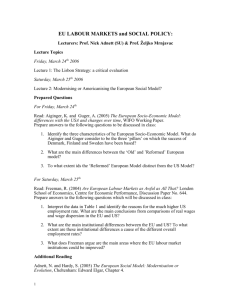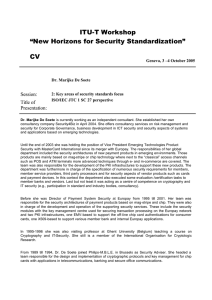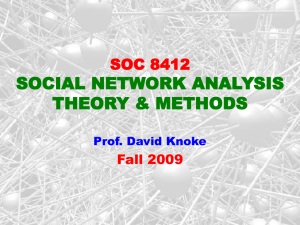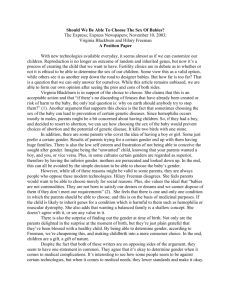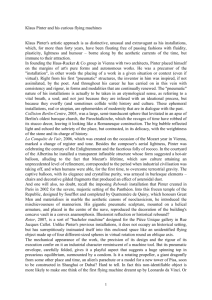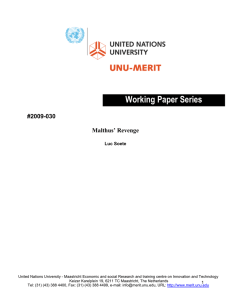The Economics of Technical Change and Employment
advertisement
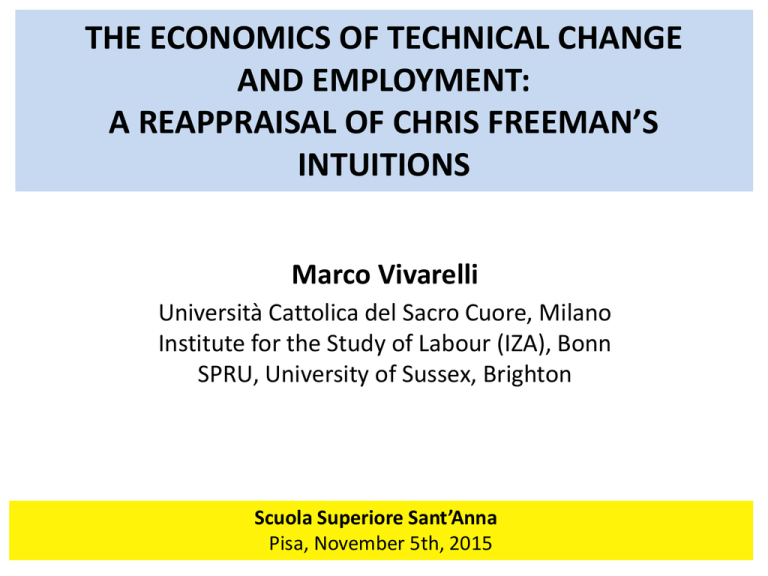
THE ECONOMICS OF TECHNICAL CHANGE AND EMPLOYMENT: A REAPPRAISAL OF CHRIS FREEMAN’S INTUITIONS Marco Vivarelli Università Cattolica del Sacro Cuore, Milano Institute for the Study of Labour (IZA), Bonn SPRU, University of Sussex, Brighton Scuola Superiore Sant’Anna Pisa, November 5th, 2015 Ned Ludd and Captain Swing against textile and threshing machineries Captain Swing by Eric Hobsbawm and George Rudé, New york, Pantheon Books, 1968 RICARDO’S SURPRISE (Title of Chapter 2 in Freeman, C. and Soete, L., Work for All or Mass Unemployment, London: Pinter, 1994) “….the opinion, entertained by the labouring class, that the employment of machinery is frequently detrimental to their interests, is not founded on prejudice and error, but is conformable to the correct principles of political economy” (Ricardo, 1951, vol 1, p. 387; third edition, 1821) CLASSICAL AND CONTROVERSIAL ISSUE (1) •“Machines cannot be constructed without considerable labour, which gives occupation to the hands they throw out of employ.” (Say, 1967, p. 87; first ed. 1803); HOWEVER: “…the machine can only be employed profitably, if it…is the (annual) product of fewer men than it replaces.” (Marx, 1969, p. 552; first ed. 1905-1910); •“The introduction of machines is found to reduce prices in a surprising manner. And if they have the effect of taking bread from hundreds, formerly employed in performing their simple operations, they have that also of giving bread to thousands.” (Steuart, 1966, vol. II, p. 256; first ed. 1767); HOWEVER: “..the increased demand for commodities by some consumers, will be balanced by a cessation of demand on the part of others, namely, the labourers who were superseded by the improvement.” (Mill, 1976, p.97; first ed. 1848) CLASSICAL AND CONTROVERSIAL ISSUE (2) •“I have before observed, too, that the increase of net incomes, estimated in commodities, which is always the consequence of improved machinery, will lead to new saving and accumulation” (Ricardo, 1951, vol 1, p. 396; third edition, 1821) ; HOWEVER: “The accumulation of capital, though originally appearing as its quantitative extension only, is effected, as we have seen, under a progressive qualitative change in its composition, under a constant increase of its constant, at the expense of its variable constituent.” (Marx, 1961, vol. 1; p. 628; first ed. 1867). •“ Entirely new branches of production, creating new fields of labour, are also formed, as the direct result either of machinery or of the general industrial changes brought about by it.” (Marx, 1961, vol. 1; p. 445 first ed. 1867); HOWEVER: “But the places occupied by these branches in the general production is, even in the most developed countries, far from important” (ibidem). THE FAIRY TALE OF TRICKLE-DOWN ECONOMICS C P D Y L NEW MACHINES PC PROCESS INNOVATION DIRECT LABOUR-SAVING EFFECT NO PC Π I D Y L L u W L THEREFORE…. “This neo-classical general equilibrium framework can be said to correspond most closely to present-day traditional economic views on technical change and employment. Technological change may indeed result in some temporary unemployment, but with efficiently operating labour and capital markets there is no basic economic problem arising from the introduction of new technology” (Freeman, C. and Soete, L., Work for All or Mass Unemployment, London: Pinter, 1994, p.25) THE CRITIQUE C P D Y L NEW MACHINES BUT: BUT: L D ; η<1; SAY’S LAW Π ; PROC; SCRAP PC PROCESS INNOVATION DIRECT LABOUR-SAVING EFFECT NO PC Π I D Y L BUT: IPROC; SAY’S LAW L u W L BUT: W D ; LOW σ (K,L); PATH DEP. NEW MACHINERY AND INVESTMENT: EMBODIED TECHNICAL CHANGE IN THE REAL WORLD “It follows that scrapping of the older equipment will in general necessitate an investment expenditure greater than the replacement value of the scrapped capital if employment levels are to be maintained” (Freeman, C., Clark, J. and Soete, L., 1982, Unemployment and Technical Innovation, London: Pinter, p.189) On the whole: “The ‘compensation effects’, which may mitigate these tendencies, operate only imperfectly and often with long delays” (Freeman, C., Clark, J. and Soete, L., 1982, Unemployment and Technical Innovation, London: Pinter, p.189) WAGES AND LABOUR-SAVING INNOVATION K _ y _ y _ KP ^ K E E’ _ y _ y ^ L w/r _ LP w/r L LOCALIZED TECHNOLOGICAL CHANGE MAKES THINGS MUCH MORE COMPLICATED K Y Y Y A B Y C A’ Y A’’ Y K L w r w r O L Adapted from Freeman, C. and Soete, L. (1987), Technical Change and Full Employment, Oxford, Basil Blackwell, p.42 INDUCED-BIAS TECHNOLOGICAL CHANGE AND WAGE FLEXIBILITY “An important conclusion follows from this overall assessment of ‘induced innovation’. It is that there is inherent plausibility in the Hicks inducement theory, biasing the long term direction of technical change in a labour-saving direction. Attempts to generate a reversal of this trend by temporary small reductions in the relative price of labour are extremely unlikely to be effective” (Freeman, C. and Soete, 1987, Technical Change and Full Employment, Oxford, Basil Blackwell, p.46) THE SKILL MISMATCH MAKES THINGS MUCH MORE COMPLICATED S _ y1 E1’ E0 S* S0’ _ y0 E0’ _ y0 U0’ U1’ wu/ws U* U EDUCATION AND TRAINING AS AN ALTERNATIVE TO LABOUR DUMPING “With respect to employment this could mean that the need for increased flexibility in occupational patterns, skill profiles, work organisation and work time may have to be combined with a search for new structures, new ‘rigidities’ which make it workable for individuals to invest in education, training and the acquisition of new skills” (Freeman, C. and Soete, L., Work for All or Mass Unemployment, London: Pinter, 1994, p.122) EMPIRICALLY….. I N N O V A T I O N I N P U T R & D PROD PROD & PROC E T C PROC I N N O V A T I O N O U T P U T JOB CREATION JOB DESTRUCTION THE ANSWER IS IN THE HISTORY AND IN THE DATA “In the early period of a long boom the emphasis is on rapid expansion of new capacity in order to get a good market share and this investment has a strong positive effect on the generation of new employment. As the new industries and technologies mature, economies of scale are exploited and the pressures shift to cost-saving innovation in process technologies. Capital-intensity increases and employment growth slows down or even stops altogether” (Freeman, C., Clark, J. and Soete, L., 1982,Unemployment and Technical Innovation,London: Pinter, p.21) THANK YOU
